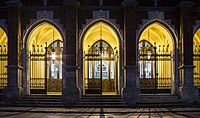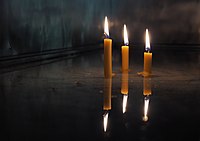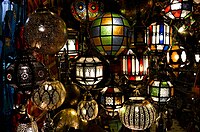Halogen lamp: Difference between revisions
wikilink |
No edit summary |
||
| Line 34: | Line 34: | ||
===Handling precautions=== |
===Handling precautions=== |
||
Any surface contamination, notably fingerprints, can damage the quartz envelope when it is heated. Contaminants will create a hot spot on the bulb surface when the bulb is turned on. This extreme, localized heat causes the quartz to change from its [[vitreous]] form into a weaker, [[crystalline]] form which leaks gas. This weakening may also cause the bulb to rapidly form a bubble, thereby weakening the bulb and leading to its failure or explosion, and creating a serious safety hazard. Consequently, manufacturers recommend that quartz lamps should be handled without touching the clear quartz, either by using a clean paper towel or carefully holding the porcelain base. If the quartz is contaminated in any way, it must be thoroughly cleaned with [[rubbing alcohol]] and dried before use. |
Any surface contamination, notably fingerprints, can damage the quartz envelope when it is heated. Contaminants will create a hot spot on the bulb surface when the bulb is turned on. This extreme, localized heat causes the quartz to change from its [[vitreous]] form into a weaker, [[crystalline]] form which leaks gas. This weakening may also cause the bulb to rapidly form a bubble, thereby weakening the bulb and leading to its failure or explosion, and creating a serious safety hazard. Consequently, manufacturers recommend that quartz lamps should be handled without touching the clear quartz, either by using a clean paper towel or carefully holding the porcelain base. If the quartz is contaminated in any way, it must be thoroughly cleaned with [[rubbing alcohol]] and dried before use. |
||
jon gould |
|||
==Applications== |
==Applications== |
||
Revision as of 10:54, 3 October 2008

A halogen lamp is an incandescent lamp in which a tungsten filament is sealed into a compact transparent envelope filled with an inert gas, plus a small amount of halogen such as iodine or bromine. The halogen cycle increases the lifetime of the bulb and prevents its darkening by redepositing tungsten from the inside of the bulb back onto the filament. The halogen lamp can operate its filament at a higher temperature than in a standard gas filled lamp of similar wattage without loss of operating life. This gives it a higher efficacy (10-30%). It also gives light of a higher color temperature compared to a non-halogen incandescent lamp. Alternatively, it may be designed to have perhaps twice the life with the same or slightly higher efficacy. Because of their smaller size, halogen lamps can advantageously be used with optical systems that are more efficient.

Principle of operation

The function of the halogen is to set up a reversible chemical reaction with the tungsten evaporating from the filament. In ordinary incandescent lamps, this tungsten is mostly deposited on the bulb. The halogen cycle keeps the bulb clean and the light output remains almost constant throughout life. At moderate temperatures the halogen reacts with the evaporating tungsten, the halide formed being moved around in the inert gas filling. At some time it will reach higher temperature regions, where it dissociates, releasing tungsten and freeing the halogen to repeat the process. In order for the reaction to operate, the overall bulb temperature must be higher than in conventional incandescent lamps. The bulb must be made of fused silica (quartz) or a high melting point glass (such as aluminosilicate). Quartz being very strong, the gas pressure can be higher, which reduces the rate of evaporation of the filament, permitting it to run a higher temperature (and so efficacy) for the same average life. The tungsten released in hotter regions does not generally redeposit where it came from, so the hotter parts of the filament eventually thin out and fail.
Regeneration of the filament is also possible with fluorine, but its chemical activity is so great that other parts of the lamp are attacked. .[1][1] [2]
The first commercial lamps used elemental iodine, were called Quartz Iodine Lamps,and were launched by GE in 1959. [3] [4] Quite soon bromine was found to have advantages, but was not used in elemental form. Certain hydrocarbon bromine compounds gave good results. [5] [1]. The first lamps used only tungsten for filament supports, but in some designs it has been possible to use molybdenum - an example being the molybdenum shield in the H4 twin filament headlight for the European Asymmetric Passing Beam.
High temperature filaments emit some energy in the UV region. Small amounts of other elements can be mixed into the quartz, so that the doped quartz (or selective optical coating) blocks harmful UV radiation. Hard glass blocks UV and has been used extensively for the bulbs of car headlights. [6] Alternatively, the halogen lamp can be mounted inside an outer bulb, similar to an ordinary incandescent lamp, which also reduces the risks from the high bulb temperature. Undoped quartz halogen lamps are used in some scientific, medical and dental instruments as a UV-B source.
For a fixed wattage and life, the efficacy of all incandescent lamps is greatest at a particular design voltage. Halogen lamps made for 12 to 24 Volt operation have good light outputs, and the very compact filaments are particularly beneficial for optical control (see picture). The range of MR16 (50 mm diameter) reflector lamps of 20W to 50W were originally conceived for the projection of 8 mm film, but are now widely used for display lighting and in the home. More recently, wider beam versions are available designed for direct use on supply voltages of 120 or 230V.
Effect of Voltage on Performance
Tungsten halogen lamps behave in a similar manner to other incandescent lamps when run on a different voltage. However the light output is reported as proportional to voltage to the power of 3, and the efficacy proportional to the power of 1.3 [7] The normal relationship regarding life is that it is proportional to voltage to the -14. For example, a bulb operated at 5% higher than its design voltage would produce about 15% more light, and the efficacy would be about 6.5% higher, but would be expected to have only half the rated life.
Halogen lamps are manufactured with enough halogen to match the rate of tungsten evaporation at their design voltage. Increasing the applied voltage increases the rate of evaporation, so at some point there may be insufficient halogen and the lamp goes black. Over-voltage operation is not generally recommended. With a reduced voltage the evaporation is lower and there may be too much halogen, which can lead to abnormal failure. At much lower voltages, the bulb temperature may be too low to support the halogen cycle, but by this time the evaporation rate is too low for the bulb to blacken significantly. There are many situations where halogen lamps are dimmed successfully. However, lamp life may not be extended as much as predicted. The life span on dimming depends on lamp construction, the halogen additive used and whether dimming is normally expected for this type.
Halogen Lamp Spectra

A Halogen incandescent lamp has a light spectrum as shown in the accompanying figure. The figure shows just the infrared end of the whole spectrum, which is limited by the resolution of the spectrum analyzer from 600nm to 1500nm, in the optical window, typical to fiber optic communication systems.
Safety
Halogen lamps get hotter than regular incandescent lamps because the heat is concentrated on a smaller envelope surface, and because the surface is closer to the filament. This high temperature is essential to their operation. Because the halogen lamp operates at very high temperatures, it can pose fire and burn hazards. Some safety codes now require halogen bulbs to be protected by a grid or grille, especially for high power (1-2kW) bulbs used in commercial theatre, or by the glass and metal housing of the fixture to prevent ignition of draperies or flammable objects in contact with the lamp. Similarly, in some areas halogen bulbs over a certain power are banned from residential use[citation needed]
Additionally, it is possible to get a sunburn from excess exposure to the UV emitted by an undoped quartz halogen lamp. To reduce unintentional UV exposure, and to contain hot bulb fragments in the event of explosive bulb failure, general-purpose lamps usually have a UV-absorbing glass filter over or around the bulb. Alternatively, lamp bulbs may be doped or coated to filter out the UV radiation. When this is done correctly, a halogen lamp with UV inhibitors will produce less UV than its standard incandescent counterpart.
Handling precautions
Any surface contamination, notably fingerprints, can damage the quartz envelope when it is heated. Contaminants will create a hot spot on the bulb surface when the bulb is turned on. This extreme, localized heat causes the quartz to change from its vitreous form into a weaker, crystalline form which leaks gas. This weakening may also cause the bulb to rapidly form a bubble, thereby weakening the bulb and leading to its failure or explosion, and creating a serious safety hazard. Consequently, manufacturers recommend that quartz lamps should be handled without touching the clear quartz, either by using a clean paper towel or carefully holding the porcelain base. If the quartz is contaminated in any way, it must be thoroughly cleaned with rubbing alcohol and dried before use. jon gould
Applications
This section needs expansion. You can help by adding to it. (August 2008) |
Halogen headlamps were widely implemented in many automobiles. Halogen floodlights for home outdoor lighting systems as well as for watercraft are also manufactured for commercial and recreational use. They are now widely used in desktop lamps.[citation needed]
References
- ^ a b Burgin and Edwards Lighting Research and Technology 1970 2.2. 95-108
- ^ Schroder Philips Technical Review 1965 26.116
- ^ Zubler and Mosby Illuminating Engineering 1959 54.734
- ^ http://home.frognet/~ejcov/newhalogen.html
- ^ T'Jampens and van der Weijer Philips Technical Review 1966 27.173
- ^ Burgin Lighting Research and Technology 1984 16. 2 71
- ^ Neumann Lichtechnik 1969 21 6 63A



